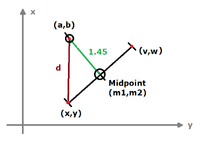Hello everyone.

- We know the coordinates of (x,y) and (v,w).
- (m1, m2) is the mid-point of (x,y) and (v,w).
- The distance between the mid-point and (a,b) is 1.45.
- d is the distance between (a,b) and (x,y).
With this data, I can calculate the distance between (x,y) and the coordinates of the midpoint. After knowing that, I can just use the c^2=h^2+h^2 rule in order to find the value of d. Now my question is how do I find out the coordinates of (a,b) in the simplest way possible?
Thanks!

- We know the coordinates of (x,y) and (v,w).
- (m1, m2) is the mid-point of (x,y) and (v,w).
- The distance between the mid-point and (a,b) is 1.45.
- d is the distance between (a,b) and (x,y).
With this data, I can calculate the distance between (x,y) and the coordinates of the midpoint. After knowing that, I can just use the c^2=h^2+h^2 rule in order to find the value of d. Now my question is how do I find out the coordinates of (a,b) in the simplest way possible?
Thanks!

